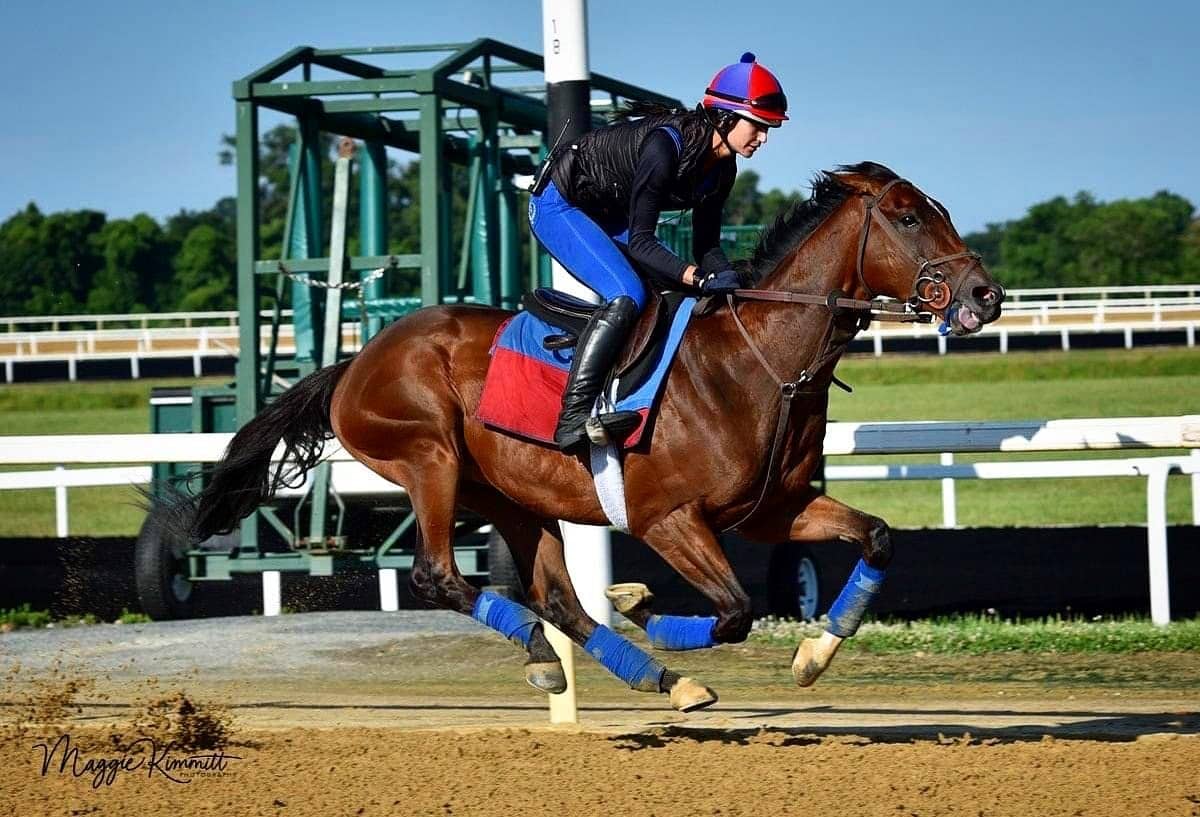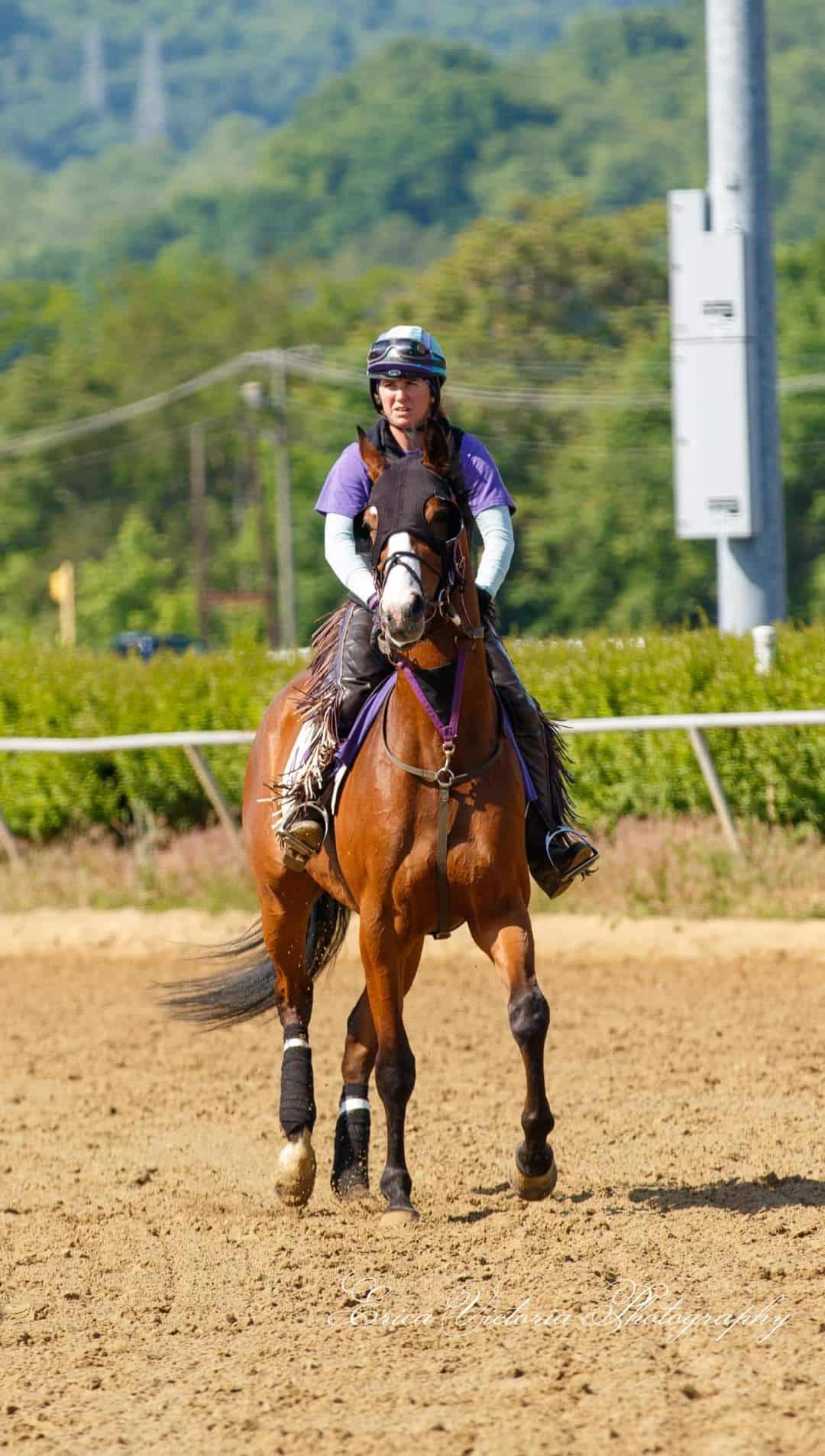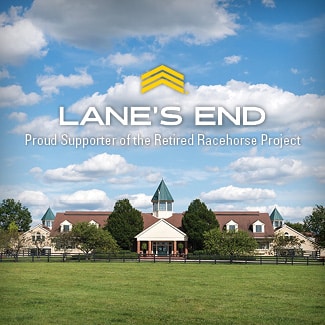Learn how jockeys and exercise riders communicate with their horses during training and races

Exercise riders, like Erin Strader on Drakesboro Wildcat, often rely on weight distribution to tell horses what to do and how to do it. Photo by Maggie Kimmitt, courtesy Erin Strader
Hands, voice, legs, seat — we use a combination of them when we ask our equine partners to perform in almost any discipline. So when we look at a jockey riding in a race, standing up in the stirrups, perched up over the horse’s withers, rear end high in the air, we have to wonder, “How on earth do they communicate with that horse effectively?”
Myths about this abound, as Erin Strader and Megan Fadlovich know well. They have their feet (and hands and seat) firmly in the worlds of both racing and showing. Strader is an upper-level eventer who gallops for top Thoroughbred racing trainer Graham Motion and has twice participated in the Retired Racehorse Project’s Thoroughbred Makeover. Fadlovich is a former jockey, now a racehorse trainer, who has competed successfully in lower-level eventing, mounted shooting and polo.
What these two women will tell you is jockeys and exercise riders can communicate just as effectively and subtly with their horses as riders in other disciplines. Depending on the task, they might do it much the same way the rest of us do, adjusting their aids to allow their mounts to perform to the best of their abilities.
Weight and Balance
Oddly enough — given that most jockeys tip the scales at not a whole lot more than 100 pounds — weight often plays the biggest role.
Strader and Fadlovich use the same term: “weight distribution.” Both cite situations in which they position their weight on a horse to communicate what to do and how to do it.
An exercise rider galloping a horse in the morning, however, often rides very differently from a jockey in a race.
“An exercise rider typically rides a little bit longer (in stirrup length) than a jockey,” Fadlovich says, who gallops some of her trainees. “I like to use a lot of leg and seat. As an exercise rider, our goal is to try and make the horse go slow.”
Until a trainer asks for a breeze or a work — exercise at speed at a certain distance — a racehorse’s morning gallops are designed to get him fit and give him a good foundation.
“We can squeeze our knees together and compress above their lungs,” she adds. “You can hold them down that way and stop them from going too quick. It’s very physical.”
Still, a dressage rider, for example, would find the stirrup length an exercise rider uses to be very short. A jockey rides with even shorter stirrups, something American jockey Todd Sloan developed in the late 1800s. Short stirrups allowed him to perch on a horse much more aerodynamically, and his horses started beating those ridden with longer stirrups.
Regardless of stirrup length and leg position, Strader says riders must find their ideal balance point. That can depend on how much they weigh — and typically exercise riders weigh 20 to 30 pounds more than jockeys — as well as how tall they are.
Strader, for instance, is 6 feet tall. “My balance point is a lot higher than shorter people,” she says. “I end up having to ride with my stirrups a little bit longer.”
Adjusting that balance point serves as a gas pedal or the brakes. Fadlovich notes that when she rode in races, she would drop her weight and her center of gravity to communicate to the horse that he should pick up speed.
“When I’m trying to slow them down, I would be standing with my legs straight, with my seat rocked back, pulling them into me,” she says. “In a race when I’d want them to stretch out, I would shift my weight a little bit forward and down, drop my back and slide my hips a little bit forward.”
Watch almost any race, especially a longer one, and you’ll see this. Jockeys often begin with their seat high in the air. Then when they want the horse to make his winning move, they sit down and urge him forward.
Indeed, weight distribution tells a racehorse many things — what speed to travel, when to change leads and when to veer in or out to go through an opening or around another horse.

Megan Fadlovich says she uses a lot of leg and seat when galloping her trainees. Erica and Victoria Photography, courtesy Megan Fadlovich
The Lead Change
Why would a racehorse need to change leads when all he does is travel on essentially a large left-hand circle? That’s perhaps one of the biggest myths about racehorses, that they only know how to turn left and use their left lead.
“People say Thoroughbreds can’t go on their right lead,” says Strader. “But they can — they go on their right lead every day. They’re just not asked to bend through their body going to the right. They’re forced to bend left because they’re turning left. But they’re not even hardly truly bending through their body going left.”
A racehorse should be on his left lead around the turns, but it’s just as important for him to switch to his right lead on the straightaways. Doing so can keep him from getting tired. Sometimes this can be very dramatic — a horse changes leads in the stretch toward the end of a race, bursts forward with speed and wins.
“We’re not necessarily using leg (to ask for a lead change),” says Fadlovich. “But it’s the same principle. If you’re going into your left lead, you’re going to shift to the right and kind of pick up your left hand to get them to switch.”
Adds Strader, “They should follow your weight and switch to their left lead.”
As in any discipline, early training of fundamental concepts like the lead change is key. Fadlovich says as a jockey she relied on the exercise rider to have taught the horse many of these things, something she now employs in teaching her charges.
Many of the most talented racehorses pick up lead changes so naturally a jockey doesn’t even have to ask. It’s the mark of a gifted athlete, she says. Likewise, a horse suddenly reluctant to pick up the correct lead could have a physical problem. Exercise riders are in an especially good position to notice this and inform the trainer, which can keep a minor ailment from becoming a major problem.
Navigating the Field
A principal difference between racetrack work and other disciplines is horses travel and compete in traffic. An eventer, for example, negotiates a cross-country course individually, whereas a racehorse might have to weave through several rivals to find the best path to victory. Communicating course changes in these tight quarters can save lives, both human and equine.
Strader and Fadlovich use a combination of rein cues and weight shifting to guide horses to the right path. They utilize a bridge or a cross, where they cross the reins over each other and hold that bridge with one or both hands.
“Usually you’re riding in a bridge,” says Strader. “The reins should just be resting on their neck.”
While weight shifting is often the most effective way to guide a racehorse, the reins do come into play.
“It’s having a still body and a solid core,” says Fadlovich. “But just like dressage riders, we’re still using our fingers. We’re rocking, we’re using our wrists. They’re just smaller movements, milking your fingers, wiggling your wrists.”
During a race, the reins can become loose in that cross. Jockeys employ what’s called “throwing a cross,” where they separate the reins by moving their hands backward and around in a circle, regripping their reins back in that bridge or cross. They can use that technique to urge the horse to pick up speed, as well.
Prioritizing Safety
Racetrack rules help keep everyone safe. In the mornings, faster workers hug the rail while slower gallopers are further out in the center of the track. Joggers travel along the outside rail in the opposite direction.
Likewise, racing has very strict rules. If the stewards (judges) determine a jockey has impeded another horse and rider, his or her mount could be disqualified and the jockey fined or suspended. This is critically important, because if a horse clips the heels of a horse in front of him, he can stumble and fall, throwing his rider to the ground.
Fadlovich and Strader point out that horses have incredible survival skills and often avoid problems on their own.
“Sometimes the animal makes the decision for you,” says Fadlovich.
Strader says most horses instinctively avoid a fallen horse or rider to stay safe. That instinct also serves them well in second careers.
“In eventing, the horse has to have great instinct,” says Strader. “They have to be quick with their feet and have to be quick in the mind. That can save us in tough situations in cross-country. They can in a second decide whether to go this way or that way.”
Ultimately, the best safety measure is good communication between horse and rider. Strader and Fadlovich use their knowledge from other disciplines to help put good foundations on horses in their care, resulting in racehorses who can go on to successful second careers.

